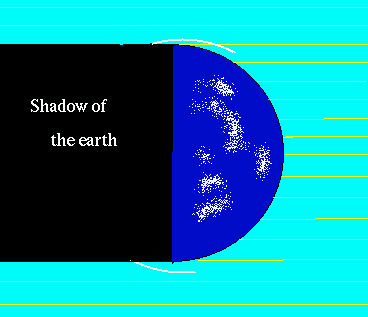
Because air is transparent, a light beam only reveals its presence when it encounters something -- a dust particle, or a surface. For this reason, we associate shadows with surfaces: your shadow lies on the ground, for example. At the same time, we should realize that a shadow actually fills the space behind the object that causes it, even though we don't usually observe it. From this point of view, we would say that your shadow exists in the region between you and the ground. Similarly the shade under a tree is a space that is filled with shadow.
Shortly after sunset on a clear day the sky above you is still in sunlight,
and small clouds and airplane contrails are brightly lit. As it gets darker,
you will observe that these effects are missing in an ever-widening zone in
the eastern sky, and that the contrails end abruptly, where they
enter the shadow-space of the earth.
There is no light there for the contrails to reflect to our eye, so
we can't see them there.
